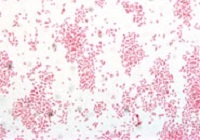 |
| Gram stain of Bordetella pertussis--Courtesy of CDC |
Whooping cough is back with a vengeance, and the culprit may be the changing nature of the bacterium that causes the highly infectious disease.
Researchers at the University of New South Wales have found that the bacterium that causes whooping cough--Bordetella pertussis--has mutated, possibly reducing the effectiveness of the pertussis vaccine.
An analysis of 2012 Bordetella pertussis strains from across Australia found that many strains no longer produce a key surface protein called pertactin, which helps pertussis bacteria attach to the lining of the airways. Pertactin-free strains represented about 80% of the 320 Australian whooping cough cases studied. Made from purified extracts of Bordetella pertussis bacteria, pertactin is one of several compounds of all pertussis vaccines.
"It is harder for the antibodies made by the body's immune system in response to vaccination to 'search and destroy' the whooping cough bacteria which lack pertactin," said senior study author Ruiting Lan, associate professor of the UNSW School of Biotechnology and Biomolecular Sciences, in a university statement. "This could mean that these pertactin-free strains have gained a selective advantage over bacterial strains with the pertactin protein."
The study also found that the proportion of pertactin-free bacteria rose from 5% of cases tested in 2008 to 78% in 2012, which corresponded with an outbreak of whooping cough in Australia during the same time period. The research findings appear in the journal Emerging Infectious Diseases.
Pertactin-free strains of pertussis have also been detected in the U.S. and France.
"The fact that they have arisen independently in different countries suggests this is in response to the vaccine," Lan said.
In the U.S., cases of whooping cough have risen dramatically in recent years. In the past decade, pertussis cases increased from 9,771 in 2002 to 48,277 in 2012, according to data from the U.S. Centers for Disease Control and Prevention.
- read the press release
- see the study